To successfully bake muffins in a solar oven, you'll need temperatures between 350-400°F, which parabolic cookers can achieve best. Start by positioning your oven in direct sunlight during peak hours (10 AM-2 PM) and preheat for 30 minutes until reaching at least 200°F. Use aluminum pans with dark surfaces for ideal heat absorption, and expect baking times of 30-45 minutes depending on the time of day and weather conditions. Monitor temperature regularly with an oven thermometer and adjust your oven's position every 30 minutes to follow the sun. Mastering these basics will open the door to consistent, perfectly baked solar muffins.
Understanding Solar Oven Temperature Ranges
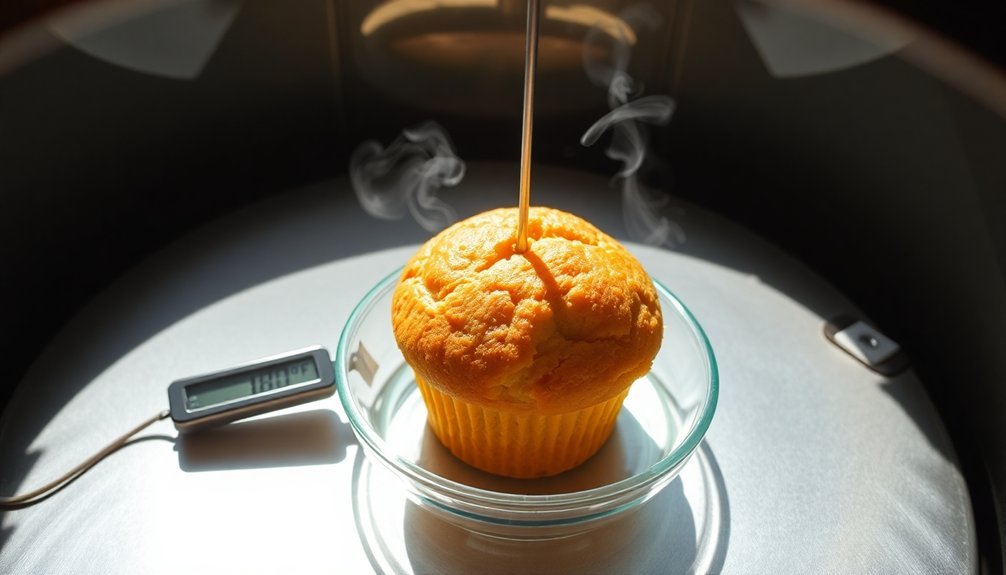
Anyone interested in solar baking needs to understand the temperature ranges of different solar oven types. For muffin baking, you'll need to achieve temperatures between 350-400°F, which means you'll need to choose your solar oven carefully.
Box-type ovens typically reach 160-400°F, with well-insulated models hitting up to 350°F – suitable for most muffin recipes. If you're using a simple design like a pizza box oven, you'll only reach 160-200°F, which won't work for muffins.
Parabolic cookers offer the highest temperatures, ranging from 300-800°F, making them ideal for muffin baking. Panel cookers, operating at 200-300°F, generally won't get hot enough for proper muffin baking. Your success depends greatly on sealing all gaps to maintain consistent temperatures.
Your oven's performance depends heavily on several factors. You'll need quality insulation materials like cotton balls or newspapers to retain heat. Proper reflector positioning is essential – use aluminum foil to line flaps and maximize sunlight concentration.
You'll get the best results between 11:00 AM and 3:00 PM when the sun's intensity is highest. Remember, factors like wind exposure and seasonal changes will affect your oven's temperature, so you'll need to monitor it closely with a thermometer.
Essential Solar Baking Equipment
A well-equipped solar baker needs specific tools and materials to create successful muffins. Your primary setup requires a cardboard pizza box or insulated container lined with aluminum foil to reflect sunlight.
You'll need clear tape to secure the foil and plastic wrap to create a greenhouse effect, while black construction paper helps absorb heat efficiently. Seal all openings with a double layer of plastic wrap to ensure maximum heat retention inside the oven.
For the actual baking process, you'll want silicone baking cups specifically designed for muffins, along with a reliable oven thermometer to monitor temperature.
Don't forget essential tools like a utility knife, ruler, and wooden spoon for assembly and support. You'll find that heavy-duty plastic bags or Reynolds oven cooking bags work well for containing heat.
To enhance your solar oven's performance, you can add newspapers or additional insulation materials to retain heat better.
Consider using mirrors or reflectors to concentrate more sunlight if you're building an advanced model. Keep a backup charcoal burner handy for cloudy days.
Remember to use nonstick spray on your baking cups, just as you'd in a conventional oven, and always have a wooden skewer ready to test your muffins for doneness.
Preparing Your Solar Oven
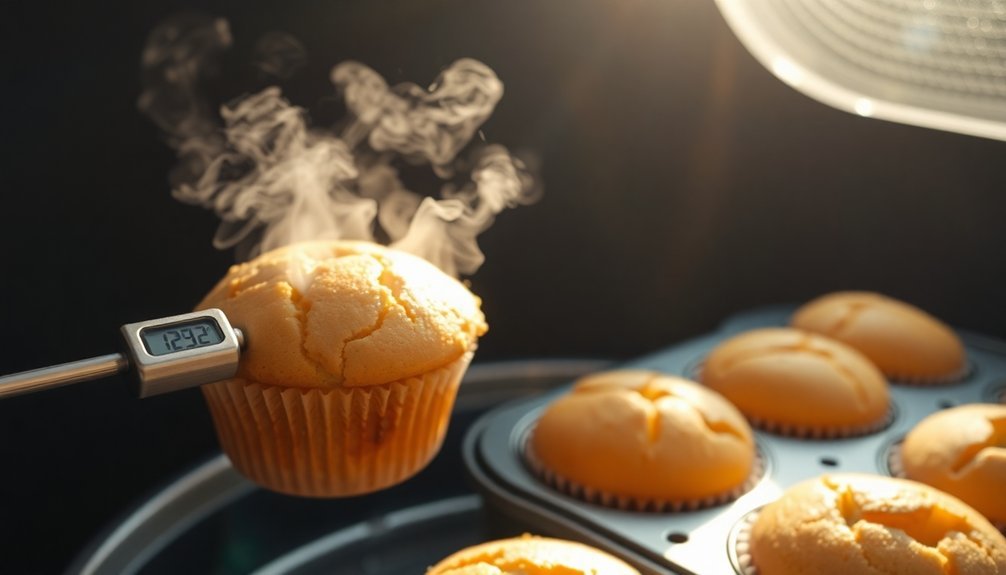
Start by thoroughly cleaning your reflective surfaces to maximize sunlight capture, making sure both the aluminum foil and plastic wrap are free from dust and smudges.
You'll want to position your oven in a sunny spot where it can catch direct sunlight for at least 2-3 hours, with the reflective flap angled to direct maximum sunlight into the box.
Before placing your muffin batter inside, let the oven preheat for 30 minutes and check that it's reached at least 200°F using a thermometer. Your solar oven can achieve temperatures of up to 550°F when properly positioned, making it versatile for various cooking methods.
Clean Reflective Surfaces First
Clean, reflective surfaces are vital for maximizing your solar oven's efficiency. When your reflective surfaces are dirty or smudged, they won't concentrate sunlight effectively, which means your muffins won't bake properly. Fingerprints, dust, and grime can greatly reduce your oven's performance, making regular cleaning important before each use.
To clean your solar oven's reflective surfaces, mix equal parts vinegar and hot water. Apply this solution using a soft, lint-free cloth, working with gentle wiping motions to avoid scratching the surfaces. Don't use paper towels, abrasive materials, or harsh chemicals like bleach or ammonia, as these can damage the reflective coating.
After cleaning, dry the surfaces thoroughly and check for any remaining smudges. You'll want to maintain your solar oven's reflective surfaces by inspecting them regularly for dirt buildup. When you're not using your oven, keep it covered and stored in a clean environment to prevent dust accumulation.
Before each baking session, give the reflective surfaces a quick inspection and cleaning to guarantee you'll get peak heat concentration for your muffins.
Position Oven Correctly
Proper positioning of your solar oven makes the difference between perfectly baked muffins and disappointing results. You'll need to find a spot with direct sunlight and no shadows to achieve ideal baking temperatures. Position your oven so it's facing directly into the sun, and remember you'll need to adjust it as the sun moves across the sky.
Wind can seriously disrupt your solar baking, so choose a sheltered location. If needed, secure your oven to prevent it from moving or tipping over. You'll also want to maximize sunlight capture by adjusting your reflector flaps – use a ruler or stick to prop them at the perfect angle.
| Time of Day | Oven Position | Reflector Adjustment |
|---|---|---|
| Morning | East-facing | 45° angle west |
| Mid-morning | Southeast | 60° angle northwest |
| Noon | Direct up | 90° angle all sides |
| Mid-afternoon | Southwest | 60° angle northeast |
| Late afternoon | West-facing | 45° angle east |
Keep checking that the oven's shadow falls directly behind it – this indicates you're maintaining ideal sun alignment. You'll need to reposition every 30 minutes to guarantee consistent temperature for your muffins.
Check Initial Temperature
Three key steps are essential before you begin baking muffins in your solar oven. First, you'll need to remove any protective film from the reflectors and conduct an initial cleaning by placing a pot of soapy water inside the chamber for 25-30 minutes. This steaming process helps sanitize the interior and glass door.
Next, you'll want to preheat your solar oven by positioning it in direct sunlight. On a clear day, your oven can reach 300°F in about 20 minutes, but you'll need at least 180°F for effective cooking. Use an oven thermometer to monitor the internal temperature accurately.
Remember that 60% of heating comes from direct sunlight through the glass door, while 40% comes from the reflectors.
For ideal muffin baking, you'll need temperatures between 300°F and 375°F. You can achieve this by baking between 11 am and 3 pm when the sun's at its peak, and the outside temperature is above 75°F.
Don't forget to realign your oven every 30 minutes to maintain consistent heat. On perfect days with clear skies, your oven might even reach 400°F.
Optimal Muffin Pan Selection
Selecting the right muffin pan can make or break your solar baking success. For solar baking, aluminum pans are your best choice due to their excellent heat conduction and even distribution properties.
You'll want to opt for light-colored pans as they're more forgiving in solar ovens, where temperature control can be challenging. Dark pans might cause overheating and burned edges since they absorb more heat.
Look for pans with encapsulated steel rims to prevent warping, which is particularly important when dealing with variable solar temperatures. If you're concerned about sticking, choose pans with reliable non-stick coatings or use a non-stick spray with flour.
Silicone pans are another excellent option as they're nonreactive and offer easy food release. Consider the pan's thickness – thicker pans provide better durability and more consistent results in solar baking.
Quilted bottoms can improve airflow, ensuring even baking in your solar oven. Don't forget about maintenance – you'll want a pan that's easy to clean and store. If you choose a steel pan, make sure you're diligent about drying it completely to prevent rust, which can compromise your baking results.
Solar Baking Time Guidelines
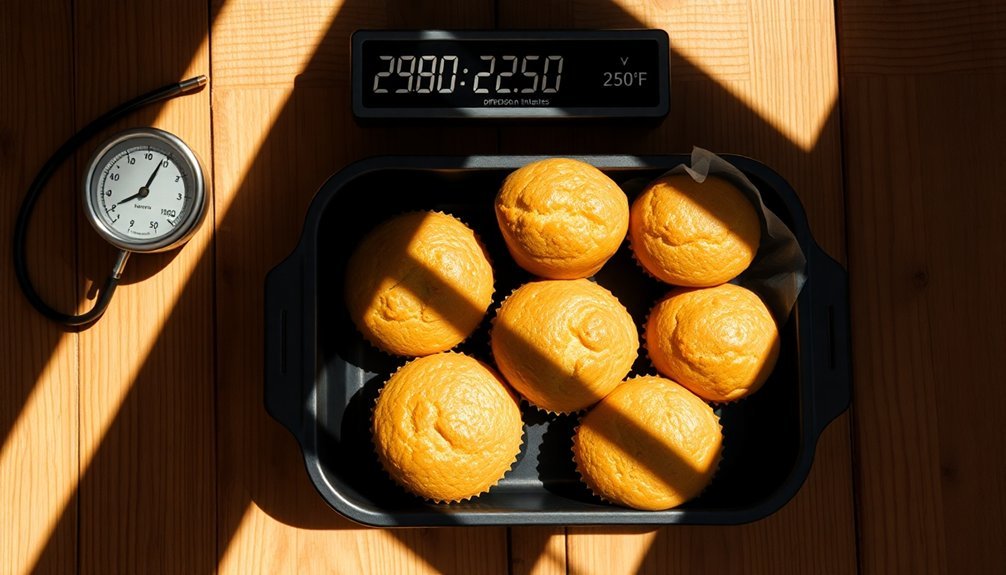
| Muffin Type | Box Oven (110-130°C) | Tube Oven (150-200°C) |
|---|---|---|
| Blueberry Cornbread | 35-40 minutes | 30-35 minutes |
| Blackberry | 45-50 minutes | 30-35 minutes |
| Sour Cream | 25-30 minutes | 20 minutes |
You'll want to preheat your solar oven before starting, just as you would with a conventional oven. Keep in mind that wind can reduce your oven's temperature, while ideal sunlight hours will vary by season and location. If you're using a box oven, you might need to add 15-20 minutes to your baking time compared to a tube oven. For best results, monitor your oven's temperature regularly and adjust cooking times accordingly. On cloudy days, expect to add 30% more time to your bake.
Weather Impact on Results
Success with solar muffin baking depends heavily on weather conditions. You'll need direct sunlight to achieve ideal temperatures between 250-350°F in your solar oven. While light clouds won't completely derail your baking, they'll extend your cooking time considerably. You can still bake if you can see your shadow, but dense cloud cover will make muffin baking impractical.
The UV index plays an essential role in your results. You'll get the best outcomes when the UV index is 7 or higher, which typically occurs during summer months. If you're baking in winter or with a lower UV index, you'll need to adjust your expectations and possibly extend baking times.
Wind can also affect your results by stealing heat from your oven, so choose a sheltered location.
To maximize your success, start baking early in the day to guarantee you'll have enough sunlight to complete the process. Use reflective materials like aluminum foil to enhance heat retention, and keep your oven well-insulated.
If you live in an area prone to cloudy weather, you'll want to plan your muffin baking for clear days and always have a backup cooking method available.
Positioning for Maximum Heat
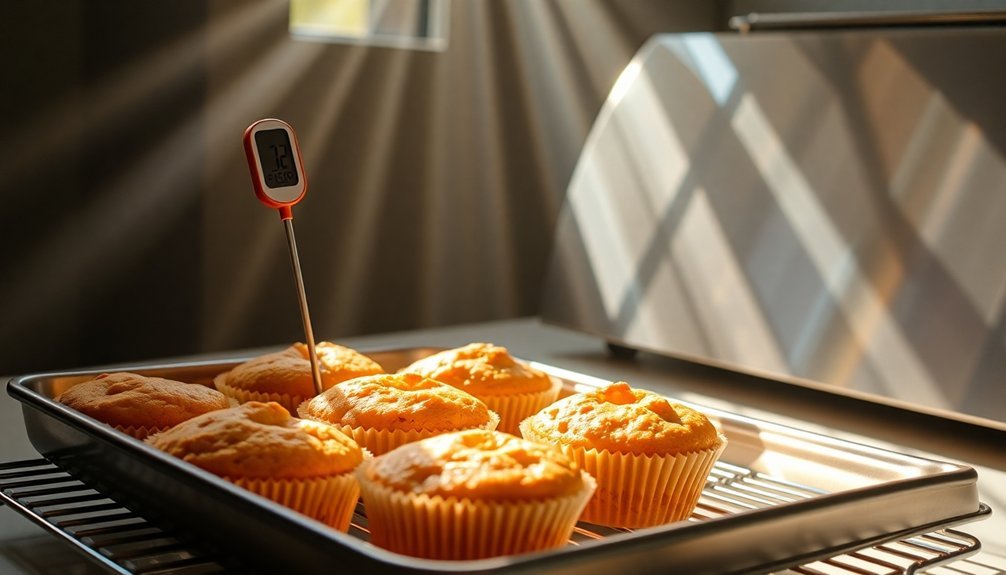
You'll want to position your solar oven by following the sun's path from east to west, orienting the shorter front panel eastward for morning baking or westward for afternoon baking.
For ideal muffin-baking temperatures, adjust the oven's angle throughout the day using rocks or brackets to maintain direct sunlight exposure.
Make sure your reflector panels are securely fastened and positioned to direct maximum sunlight into the cooking chamber, with the front flap angled to capture additional rays.
Tracking Sun's Daily Path
Proper sun tracking plays an essential role in successful solar muffin baking. You'll need to understand both the sun's daily path and seasonal variations to achieve ideal baking results.
Start by checking your local sunrise and sunset times, as these will determine your available baking window. For the best results, you'll want to bake your muffins during peak sun hours, typically between 10 AM and 4 PM when the sun's altitude is highest. During this period, you'll get maximum solar intensity, which translates to better baking temperatures.
Position your solar oven by tracking the sun's azimuth – it'll move from east to west throughout the day, so you'll need to adjust your oven's orientation accordingly.
Keep an eye on weather conditions, as cloud cover will greatly impact your baking time. You'll want to check weather forecasts beforehand and plan for clear-sky days.
Watch out for potential shade from nearby trees or buildings that might block direct sunlight. If you're dealing with partial cloud cover, you'll need to extend your baking time and monitor your muffins more carefully.
Optimal Angle Adjustments
Achieving maximum heat in your solar oven depends heavily on precise angle adjustments throughout the baking process. For ideal muffin baking, you'll need to position your oven in a sunny spot that's protected from wind, ensuring it faces directly into the sun.
Make sure your oven sits level to prevent your muffin batter from spilling. To capture maximum sunlight, you'll need to adjust your reflectors carefully. Tilt the top reflector at a steeper angle and the bottom one more shallowly, ensuring the sun's rays hit your entire cooking surface.
You can use a bright object in the target area to verify proper reflection patterns. During winter months, you'll need to set your oven at a steeper angle to compensate for the sun's lower position.
For easier adjustments, consider mounting your oven on a rotating base like a Lazy Susan. This setup allows you to track the sun's movement without lifting the entire unit. If you're using a box cooker, take advantage of its adjustable angles to accommodate seasonal changes.
Remember that your latitude and the time of year will influence the ideal angle settings for your solar muffin baking.
Reflector Panel Placement
Reflector panel placement serves as the cornerstone of successful solar muffin baking. You'll need to position your reflector panels so they concentrate sunlight directly onto your muffin pan through the cooker's clear window.
Make certain the reflected light hits both the bottom and sides of your pan for even baking. To achieve ideal heat concentration, adjust your reflectors so that the light from their upper edges touches the far side of your cooker's glazing.
You'll find that multiple small mirrors or a single large reflector can work effectively, depending on your cooker's design. Position the panels to account for your muffin pan's size and shape, guaranteeing complete coverage of the baking area.
As the sun moves across the sky, you'll need to rotate your reflectors approximately 10 degrees per hour. When the sun's directly overhead, set your reflectors at about 30 degrees away from the box.
During sunrise or sunset, keep the sunward reflector horizontal while angling the opposite reflector 30 degrees toward the sun. Remember that consistent monitoring and adjustment of your reflector panels throughout the baking process will guarantee your muffins receive steady, concentrated heat.
Monitoring Muffin Progress
Successful solar muffin baking requires careful attention to timing and conditions. On sunny days, you'll need about 30-35 minutes of baking time, but you'll want to extend this during cloudy conditions. Check your muffins regularly for a golden-brown color and test doneness with a toothpick.
You'll need to maintain ideal cooking conditions by positioning your solar oven directly toward the sun and adjusting it hourly. Keep the glass and reflective surfaces clean, and use silicone baking cups to prevent sticking. It's vital to rotate and tilt the oven frequently to maximize sunlight exposure.
Managing moisture is critical in solar baking. Since solar ovens retain more moisture than conventional ovens, you'll want to reduce liquid ingredients in your recipe. Create a small airspace by placing a matchstick between the glass and gasket to allow moisture to escape.
When checking condensation, combine this with your regular doneness checks to minimize heat loss. Always monitor internal oven temperature with a thermometer if possible, and be prepared to adjust cooking times based on sun intensity.
Keep your oven protected from strong winds to maintain consistent cooking conditions.
Temperature Control Techniques
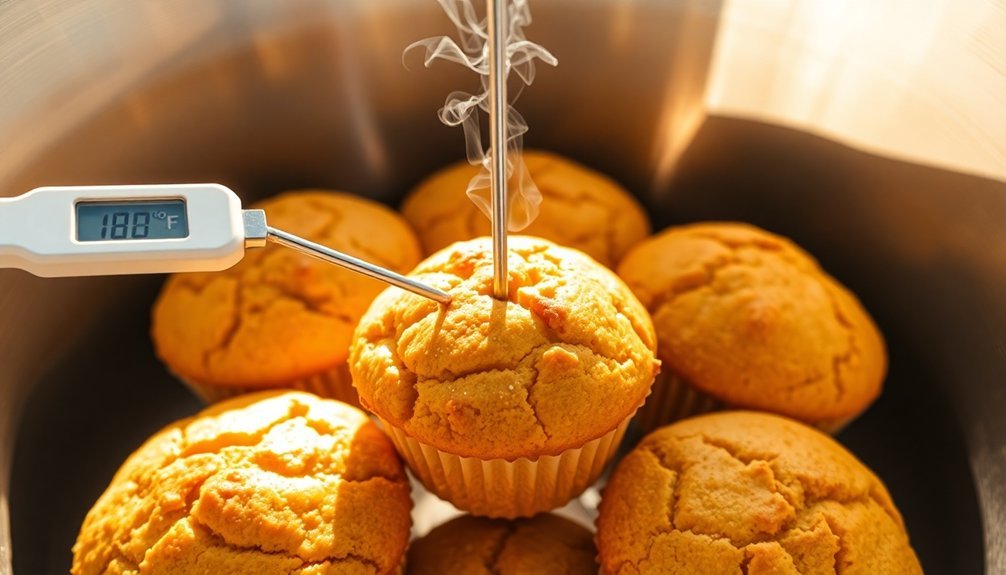
Proper temperature control in solar muffin baking depends on multiple key factors. To maintain consistent heat, you'll need to line your oven's bottom with black construction paper and use dark-colored muffin tins for maximum heat absorption.
Add layers of wadded newspaper around the oven's exterior and guarantee all seals are airtight to prevent heat loss.
Your reflective surfaces play a vital role in temperature management. Position aluminum foil panels to direct sunlight into the cooking chamber, and adjust them every 30 minutes to track the sun's movement.
You'll want to keep these surfaces clean using a vinegar-water solution for best reflection. Cover the oven with clear plastic wrap or a glass lid to trap heat effectively.
Keep your oven temperature between 150°F and 400°F, with 180°F being the minimum for proper muffin baking. Use a thermometer to monitor internal temperatures and make necessary adjustments.
During winter months, you'll need to track the sun more frequently and extend cooking times. Plan your baking between 11:00 am and 3:00 pm when sunlight is strongest, and adjust cooking duration based on weather conditions.
Best Times for Solar Baking
Now that you've mastered temperature control, timing your solar baking becomes the next key to success. You'll want to focus on peak sun hours between 10 AM and 4 PM, when the sun's intensity is at its strongest. During summer months, you'll find the most consistent results, while spring and fall require longer baking times.
| Time of Day | Sunlight Intensity | Muffin Baking Time |
|---|---|---|
| 10AM-12PM | Increasing | 40-45 minutes |
| 12PM-2PM | Maximum | 30-35 minutes |
| 2PM-4PM | Decreasing | 45-50 minutes |
| After 4PM | Low | Not recommended |
For ideal results, you'll need to monitor your solar oven closely and adjust its position every hour to track the sun's movement. Clear skies are essential – avoid baking on cloudy or windy days, as these conditions will greatly reduce your oven's efficiency. When baking muffins, you'll typically need 30-50 minutes depending on your recipe and sun conditions. Remember to test for doneness periodically, as solar baking times can vary based on environmental factors and season.
Batch Size Considerations
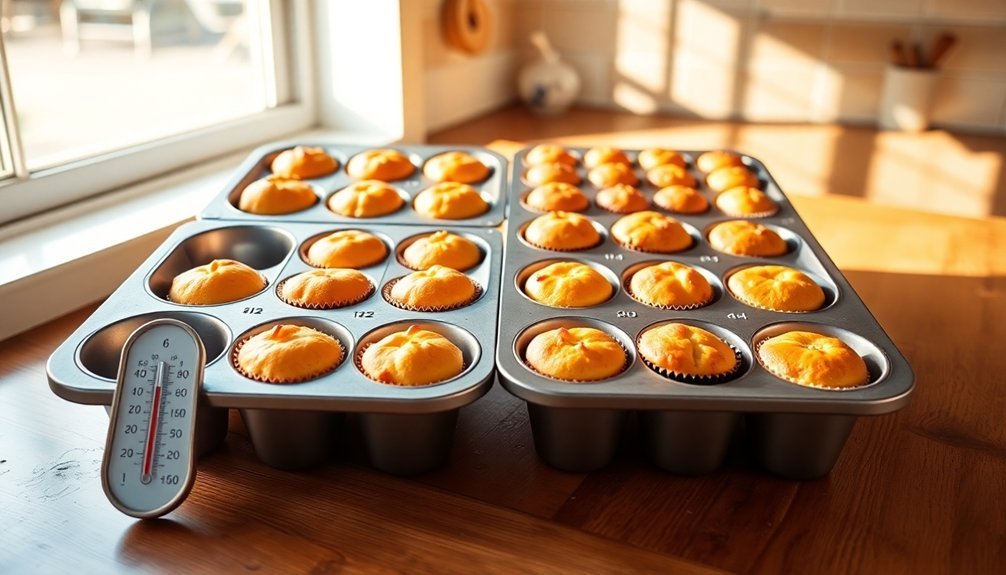
Managing batch sizes effectively is essential for solar muffin baking success. You'll get the best results by using mini-muffin tins or small loaf pans, as these containers promote even heat distribution and faster cooking times.
If you're using a wider solar oven like the Sport Solar Oven, you can cross-stack multiple muffin pans to maximize your baking capacity.
Remember that larger batches require longer cooking times, so you'll need to adjust your timing accordingly. If you're baking a substantial quantity of muffins, consider splitting them into multiple baking sessions to maintain quality and consistency.
When selecting your containers, opt for smaller sizes that will help reduce cooking time and guarantee uniform results.
To optimize your baking efficiency, you'll want to use vapor barriers and greenhouse film to prevent moisture loss and maintain consistent temperatures.
If your solar oven has the capability, adding internal solar-powered fans can help distribute heat more evenly during peak temperature periods.
Don't forget to properly seal and insulate your oven to maintain steady temperatures throughout the baking process.
Storage and Serving Tips
Once your solar-baked muffins come out of the oven, you'll want to focus on storage techniques that preserve their freshness and flavor.
Place your muffins on a wire cooling rack to prevent sogginess, and let them cool completely before storing. Instead of using airtight containers, wrap your muffins in a clean flour-sack dish towel or paper bag to maintain the right moisture balance.
Store your muffins in a cool, dry place, arranging them in a single layer to prevent sticking. If you've made extra, you can freeze them for later use and thaw them at room temperature when needed.
When serving, slice your muffins just before eating and consider warming them gently in your solar oven for the best texture.
To manage moisture during the baking process, you'll need to make a few adjustments. Reduce liquid content in your recipes to minimize condensation, and leave a small airspace when covering your solar oven.
Remember to check and wipe away condensation from the glass periodically. For ideal results, keep your solar oven well-ventilated and clean, rotating it as needed to guarantee even baking.
Frequently Asked Questions
Can I Use Silicone Muffin Molds in a Solar Oven?
Yes, you can use silicone muffin molds in your solar oven, as they're safe at typical solar cooking temperatures around 160-200°F. Just guarantee they're properly supported and don't contact concentrated sunlight or reflective surfaces.
What Happens if Clouds Appear Halfway Through Baking Muffins?
If clouds appear midway through baking, your muffins will take longer to cook. You'll need to extend the baking time and check them more frequently, as the temperature drop can affect their even baking.
Do Different Colored Muffin Batters Affect Solar Baking Time?
Yes, your darker batters (like chocolate) will absorb heat faster than lighter ones, slightly reducing baking time. However, you'll still need to monitor doneness carefully since the difference isn't dramatic enough to alter timing considerably.
Will Altitude Affect My Solar Muffin Baking Results?
Yes, altitude will affect your muffin baking results. You'll need to adjust ingredients and expect longer baking times. At higher elevations, you'll face faster liquid evaporation and more gas expansion in your batter.
Can I Add Frozen Fruit to My Muffin Batter When Solar Baking?
Yes, you can add frozen fruit directly to your muffin batter! Don't thaw it first – frozen fruit won't burst or leak, and it'll maintain its shape and flavor while baking. Just fold it in gently.
In Summary
Now you're ready to start your solar muffin baking adventure. With the right equipment, timing, and temperature control, you'll create delicious muffins using the sun's energy. Remember to check your local weather forecast, position your solar oven correctly, and monitor internal temperatures. Don't forget to adjust baking times based on batch size and sunlight conditions. Store your solar-baked muffins properly to maintain freshness and enjoy your eco-friendly treats!


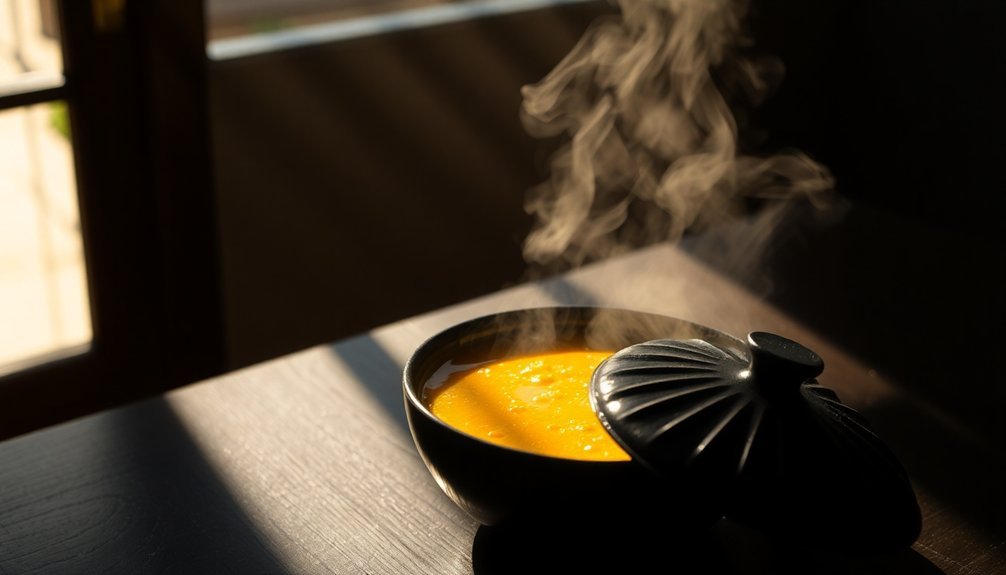
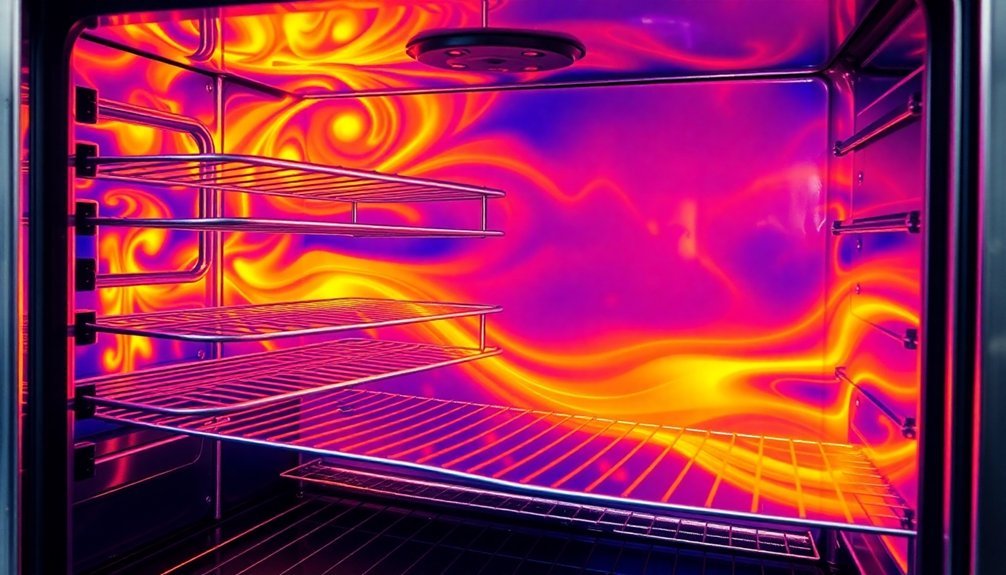
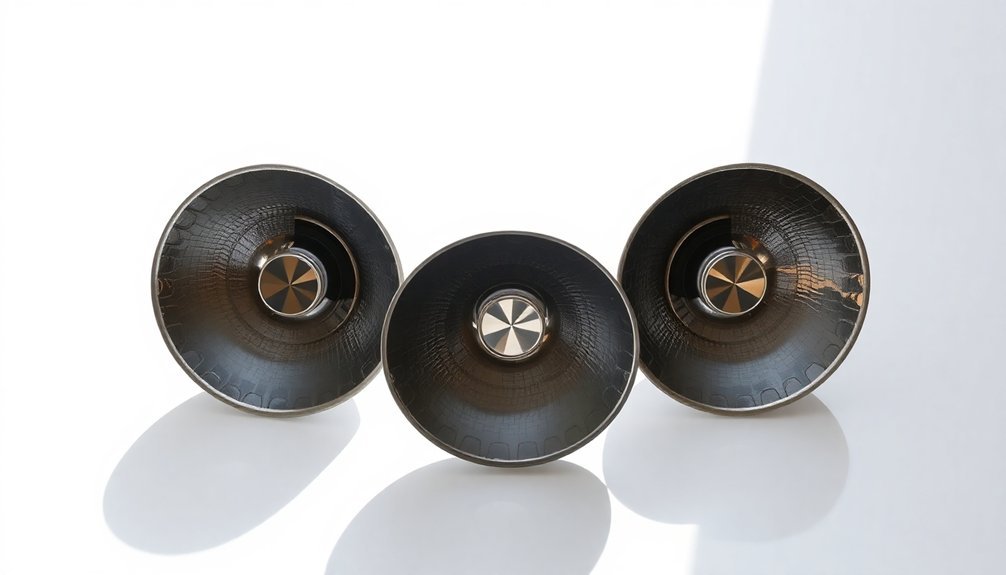
Leave a Reply